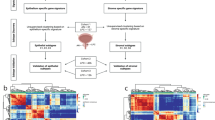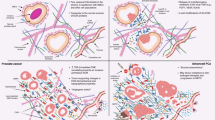Abstract
We measured the histologic stromal and epithelial tissue components of the benign (normal) and malignant tissue compartments of Japanese-Americans (J-A) and native Japanese (NJ) men living in Japan. The patient cohort included 25 NJ men undergoing radical prostatectomy (RP) in Nagoya, Japan and 25 J-A (second or third generation US born). We conducted tissue image quantitation (in-house image software) of the stromal and epithelial compartments in malignant and adjacent normal tissue areas from a tissue microarray (TMA) selected from radical prostatectomy (RP) blocks. Stromal–epithelial (S–E) areas were determined using immunohistochemical stains for CAM-5.2 epithelial cytokeratin marker and the Masson trichrome stain to measure the stroma component. We observed differences in the volumes of normal and cancer epithelium and stroma within both the J-A and NJ study populations (P<0.01). Only the individual average cancer epithelium (CE) volume (JA=24.1 vs NJ=29.9) differed significantly between the NJ and J-A study populations (P=0.03). Consequently, the S–E ratio in NJ group was significantly different from that of J-A population (P=0.05). The decrease in S–E ratio noted in the malignant tissues of NJ prostate tissue may provide a biological marker for differentiation of the two groups and suggests a need for further investigations into the molecular basis for these histologic differences.
This is a preview of subscription content, access via your institution
Access options
Subscribe to this journal
Receive 4 print issues and online access
$259.00 per year
only $64.75 per issue
Buy this article
- Purchase on Springer Link
- Instant access to full article PDF
Prices may be subject to local taxes which are calculated during checkout


Similar content being viewed by others
References
Carter HB, Partin AW . Diagnosis and staging of prostate cancer. In: Walsh PC, Retik AB, Vaughan ED, Wein AJ. Campbell's Urology. Elsevier Science: New York 2002; pp 3055–3079.
National Prostate Cancer Coalition 2002; Fact Sheet. (Accessed June 2002).
Polascik TJ, Oesterling JE, Partin AW . Prostate specific antigen: a decade of discovery—what we have learned and where we are going. J Urol 1999; 162 (2): 293–306.
Freedland SJ et al. Time trends in biochemical recurrence after radical prostatectomy: results of the SEARCH database. Urology 2003; 61: 736–741.
Pound CR et al. Natural history of progression after PSA elevation following radical prostatectomy. JAMA 1999; 281: 1591–1597.
Hsing AW, Devesa SS . Trends and patterns in prostate cancer incidence and mortality. What do they suggest? Epidemiology Rev 2001; 23: 3–13.
Cook LS, Goldoft M, Schwartz SM, Weiss NS . Incidence of adenocarcinoma of the prostate in Asian immigrants to the United States and their descendants. J Urol 1999; 161: 152.
Lee C et al. Incidence of genitourinary cancer in Korea. J Korean Med Sci 1992; 7: 154–161.
Kuwahara M et al. Mass screening for prostate cancer: a comparative study in Natori, Japan and Changchun, China. Urology 2003; 61: 137–141.
Egawa S et al. Probability of prostate cancer at various levels of percent free prostate specific antigen in Japanese men with total PSA of 4.1–10.0 ng/ml. Prostate Cancer P D 2002; 5: 115–118.
Fukagai T et al. Clinical–pathological comparison of clinical prostate cancer between Japanese Americans in Hawaii and Japanese living in Japan. Int J Androl 2000; 23: 43.
Shibata A et al. Serum levels of prostate specific antigen among Japanese Americans and Native Japanese men. J Natl Cancer Inst 1997; 89: 1716.
Whittemore AS et al. Prostate cancer in relation to diet, physical activity, and body size in blacks, whites and Asians in the United States and Canada. J Natl Cancer Inst 1995; 87: 652.
Nelson WG, DeWeese TL, Demarzo AM . The diet, prostate inflammation, and the development of prostate cancer. Cancer Metast Rev 2002; 21: 3–16.
Hayward SW, Rosen MA, Cunha GR . Stromal–epithelial interactions in the normal and neoplastic prostate. Br J Urol 1997; 79: 18.
Cunya GR et al. Role of the stromal microenvironment in carcinogenesis of the prostate. Int J Cancer 2003; 107: 1–10.
Bonkhoff H, Remberger K . Differentiation pathways and histogenic aspects of normal and abnormal prostatic growth: a stem cell model. Prostate 1996; 28: 98.
Chung LW . Implications of stromal–epithelial interaction in human prostate cancer growth, progression and differentiation. Semin Cancer Biol 1993; 4: 183.
Hayward SW . Approaches to modeling stromal–epithelial interactions. J Urol 2002; 168: 1165.
Tuxhorn JA, Ayala GE, Rowley DR . Reactive stroma in prostate cancer progression. J Urol 2001; 166: 2472.
Ayala G et al. Reactive stroma as a predictor of biochemical-free recurrence in prostate cancer. Clin Cancer Res 2003; 9: 4792–4801.
Chung LWK . Prostate carcinoma bone–stroma interaction and its biologic and therapeutic implications. Cancer 2003; 97 (3 Suppl): 772–778.
Risbridger GP, Bianco JJ, Ellem SJ, McPherson SJ . Oesterogens and prostate cancer. Endocr-Relat Cancer 2003; 10: 187–191.
Litinov IV, DeMarzo AM, Isaacs JT . Genetics of endocrine disease: is the Achilles heel for prostate cancer therapy a gain of function in androgen receptor signaling? J Clin Endocrinol Metab 2003; 88: 2972–2982.
Shapiro E, Becich MJ, Hartanto V, Lepor H . The relative proportion of stromal and epithelial hyperplasia is related to the development of symptomatic benign prostatic hyperplasia. J Urol 1992; 147: 1293.
Cadeddu JA et al. Relationship between changes in prostate-specific antigen and the percent of prostatic epithelium in men with benign prostatic hyperplasia. Adult Urol 1995; 45: 795.
Marks LS et al. Long term effects of finasteride on prostate tissue composition. Urology 1999; 53: 574–580.
O'Leary MP . Lower urinary tract symptoms/benign prostatic hyperplasia: maintaining symptom control and reducing complications. Urology 2003; 62 (Suppl 3A): 15–23.
De Marzo AM, Nelson WG, Isaacs WB, Epstein JI . Pathological and molecular aspects of prostate cancer. Lancet 2003; 361: 955–964.
Gonzalgo ML, Isaacs WB . Molecular pathways to prostate cancer. J Urol 2003; 170: 2444–2452.
Platz EA, DeMarzo AM . Epidemiology of inflammation and prostate cancer. J Urol 2004; 171 (Suppl): 36–40.
Aoki Y et al. Racial differences in cellular composition of benign prostatic hyperplasia. Prostate 2001; 49: 243–250.
Marks LS et al. Prostate cancer in native Japanese and Japanese-American men. J Urol 2003; 169 (Suppl): 48 (Abstract No. 185).
Lapointe J et al. Gene expression profiling clinically identifies relevant subtypes of prostate cancer. Proc Natl Acad Sci 2004; 101: 811–816.
Acknowledgements
This work was supported by NIH/NCI SPORE Grant P50CA58236; NIH/NCI Early Detection Research Network Grant #CA8623-02; Prostate Cancer Foundation (CaPCURE); The Elsa Pardee Foundation. This study was also supported by a generous gift from the Urological Sciences Research Foundation (Culver City, CA, USA). The tissue microarrays were produced by Helen Fedor through the Pathology Core (P.I. Angelo De Marzo) of the Johns Hopkins University Prostate Cancer SPORE Grant.
Author information
Authors and Affiliations
Corresponding author
Rights and permissions
About this article
Cite this article
Veltri, R., Park, J., Miller, M. et al. Stromal–epithelial measurements of prostate cancer in native Japanese and Japanese-American men. Prostate Cancer Prostatic Dis 7, 232–237 (2004). https://doi.org/10.1038/sj.pcan.4500738
Received:
Revised:
Accepted:
Published:
Issue Date:
DOI: https://doi.org/10.1038/sj.pcan.4500738
Keywords
This article is cited by
-
Epithelium percentage estimation facilitates epithelial quantitative protein measurement in tissue specimens
Clinical Proteomics (2013)



